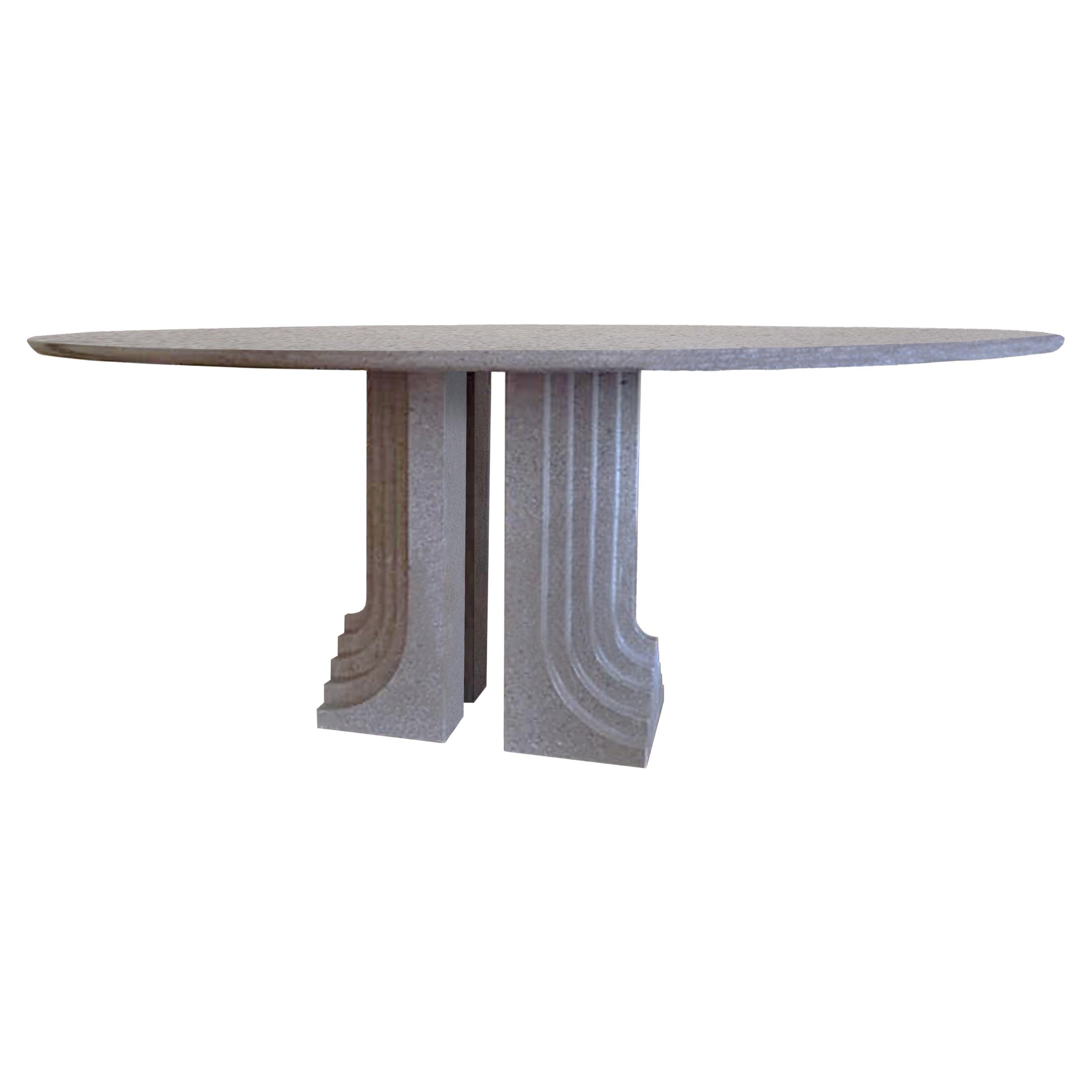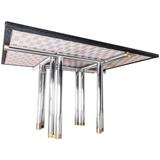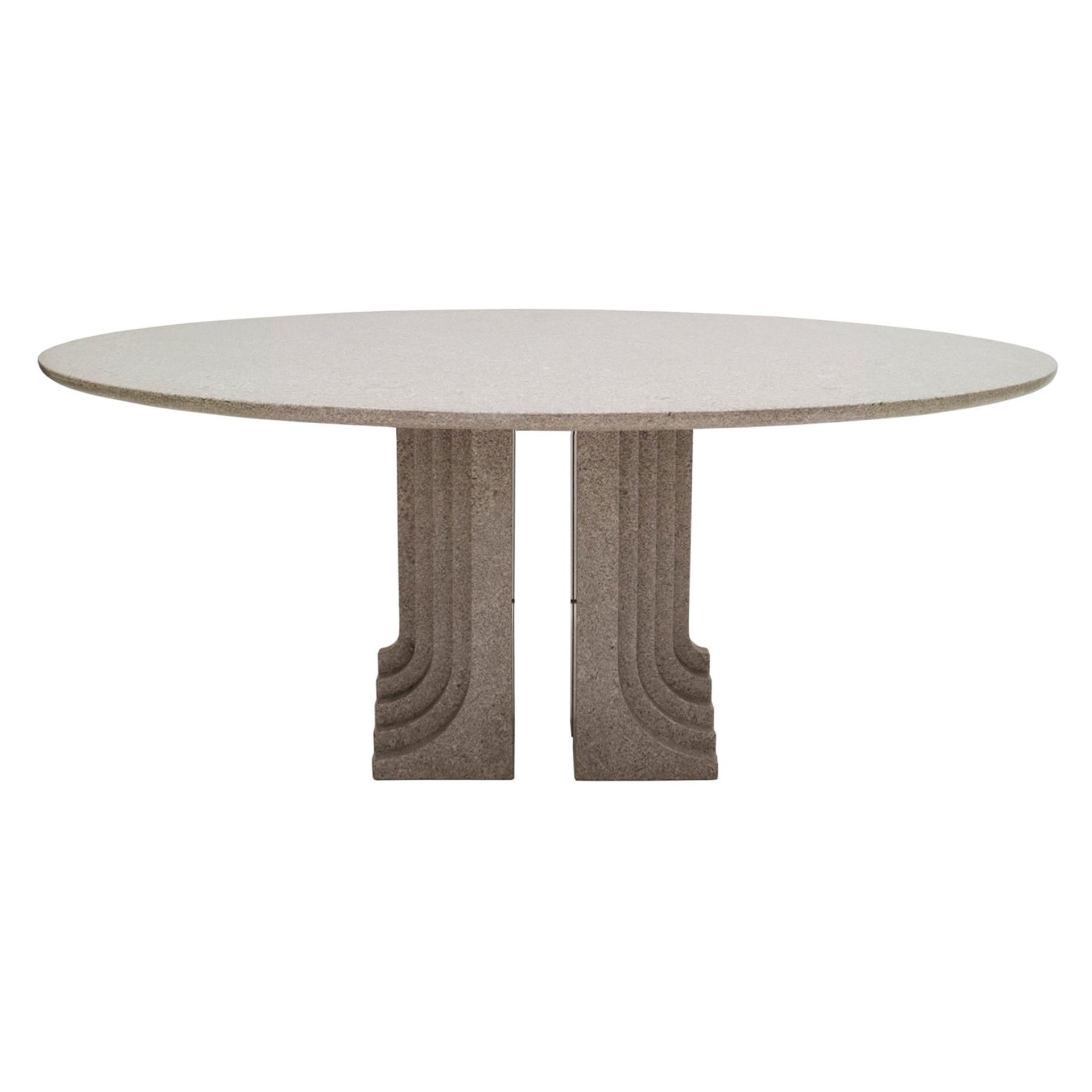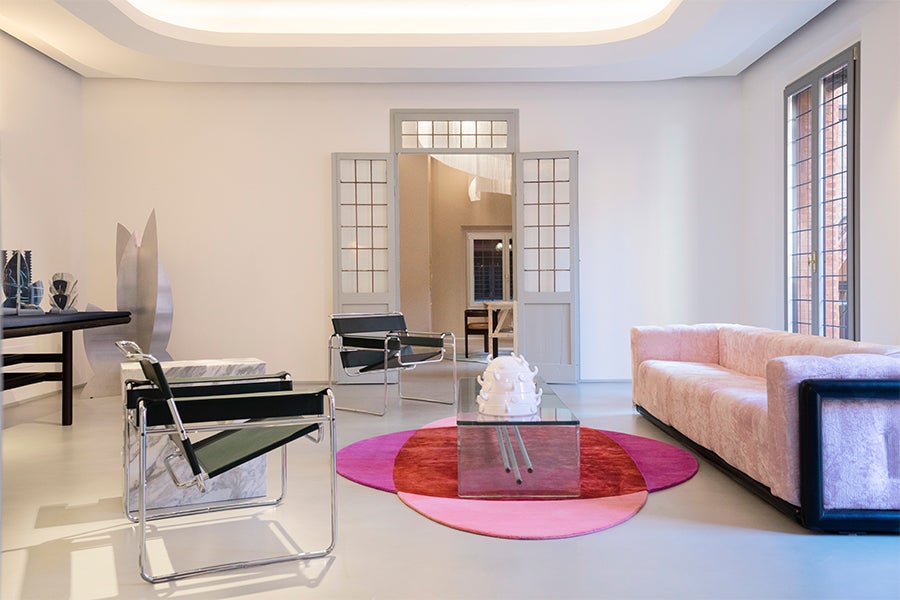Items Similar to Davide Table by Studio Simon, 1970
Want more images or videos?
Request additional images or videos from the seller
1 of 6
Davide Table by Studio Simon, 1970
About the Item
Davide table designed by Studio Simon and produced by Simon.
Partially foldable chromed steel structure, transparent glass top.
Bibliography:
Fondazione Scientifica Querini Stampalia, “Dino Gavina, collezioni emblematiche del moderno dal 1950 al 1992”, Jaca Book, Milano 1992, p. 79
- Creator:Studio Simon (Designer)
- Dimensions:Height: 28.35 in (72 cm)Width: 69.3 in (176 cm)Depth: 34.65 in (88 cm)
- Style:Mid-Century Modern (Of the Period)
- Materials and Techniques:
- Place of Origin:
- Period:
- Date of Manufacture:1970
- Condition:
- Seller Location:Ozzano Dell'emilia, IT
- Reference Number:1stDibs: LU8430234688032
Paradisoterrestre
Historic Italian design brand Paradisoterrestre was conceived in the late Seventies by eclectic and subversive Dino Gavina (1922 – 2007) and relaunched in 2017 by Gherardo Tonelli. In its new course Paradisoterrestre presents a catalogue ranging ranging from re-editions of historical pieces - designed among the others by Roberto Matta, Kazuhide Takahama and Man Ray - to new collections in collaboration with designers and artists such as Pierre Gonalons, Tobia Scarpa, Paola Pivi and Allen Jones. Paradisoterrestre offers also a curated selection of vintage collectible design and artworks realized by great masters among which Achille and Pier Giacomo Castiglioni, Luigi Caccia Dominioni, Ignazio Gardella, Vico Magistretti, Enzo Mari, Carlo Scarpa, Tobia Scarpa, Kazuhide Takahama, Augusto Betti, Alberto Biasi, Roberto Matta, Augusto Betti, ... In 2018 Paradisoterrestre opened its gallery in Bologna, a hybrid space between art and design, where major exhibitions took place: ULTRAMATTA - Roberto Matta's amazing adventure in the world of design (2019), TOBIA SCARPA - Dall’arte della misura silenziosamente (2020), Paola Pivi - Rock the art (2021), Augusto Betti - Trasversale • Pulsazione • Ritmo (2022) and Cento % Dino (2022).
About the Seller
No Reviews Yet
Recognized Seller
These prestigious sellers are industry leaders and represent the highest echelon for item quality and design.
Established in 2017
1stDibs seller since 2023
Typical response time: 12 hours
- ShippingRetrieving quote...Ships From: Ozzano Dell'emilia, Italy
- Return PolicyThis item cannot be returned.
More From This SellerView All
- Gritti Table by Carlo Scarpa produced by Simon in 1976By Carlo ScarpaLocated in Ozzano Dell'emilia, ITGritti table by Carlo Scarpa produced by Simon in 1976. A large table made with solid wood cylinders. Top covered in original cloth. Bibliography: Acca...Category
Vintage 1970s Italian Mid-Century Modern Tables
MaterialsWood, Fabric
- Balla Screen by Giacomo Balla Produced by Simon International in 1971By Giacomo BallaLocated in Ozzano Dell'emilia, ITFolding screen realized based on a project designed by Giacomo Balla in 1916-18. Multilayer wood structure. Set composed by two pieces, each with three panels linked with folding hin...Category
Vintage 1970s Italian Mid-Century Modern Screens and Room Dividers
MaterialsWood
- Glass Coffee Table by Augusto Betti Paradisoterrestre EditionBy Paradisoterrestre, Augusto BettiLocated in Ozzano Dell'emilia, ITDesigned in 1967 - Paradisoterrestre Edition 2023 Materials: glass Colours: smoked grey or bronze Designed by Augusto Betti in 1967, Glass coffee table consists of a smoked...Category
21st Century and Contemporary Italian Mid-Century Modern Coffee and Cock...
MaterialsGlass
- The Other Side Marble Side Table by Pierre Gonalons Paradisoterrestre EditionBy Pierre Gonalons, ParadisoterrestreLocated in Ozzano Dell'emilia, ITMaterials: French marble green “Vert d’Estours” and black “Petit Antique” Colours: green and black (also available in white and black) For Paradisoterrestre Pierre Gonalons design...Category
21st Century and Contemporary Italian Side Tables
MaterialsMarble
- The Other Side Marble Coffee Table by Pierre Gonalons Paradisoterrestre EditionBy Pierre Gonalons, ParadisoterrestreLocated in Ozzano Dell'emilia, ITMaterials: French marble green “Vert d’Estours” and black “Petit Antique” Colours: green and black (also available in white and black) For Paradisoterrestre Pierre Gonalons design...Category
21st Century and Contemporary Italian Coffee and Cocktail Tables
MaterialsMarble
- Naeko Sofa by Kazuhide Takahama Special Edition by Kiko KostadinovBy Kiko Kostadinov, Paradisoterrestre, Kazuhide TakahamaLocated in Ozzano Dell'emilia, ITDesigned in 1958 - Paradisoterrestre Edition 2023 Materials: cherry-wood structure, brass finishes, polyurethane foam padding, upholstery in jacquard fabrics designed by Kiko Kostadinov...Category
21st Century and Contemporary Italian Mid-Century Modern Sofas
MaterialsBrass
You May Also Like
- Studio Simon Granite Brutalist Samo Table in the Style of Carlo Scarpa, 1970By Carlo Scarpa, Studio SimonLocated in Vicenza, ITDining table mod. ‘Samo’ by Studio Simon. Series ‘Ultrarazionale’. Italy, 1970. Made of granite. Literature: Giuliana Gramigna, Repertorio 1950-2000, Allemandi, Torino, 2003, p.180. Excellent vintage condition. The Samo table was designed in 1970 by the project office of Studio Simon. Carlo Scarpa was the brand's artistic director, and the Venetian architect's style inspired the shapes of this table. Born in Venice on June 2nd, 1906, Carlo Scarpa began working at a very early age. Only a year after he had first qualified as an architect in 1926, he began working for the Murano glassmakers Cappellin & Co. in a consultative capacity; from 1927, he began to experiment with the Murano glass, and this research not only gave him excellent results here but would also inform his progress for many years to come. Between 1935 and 1937, as he entered his thirties, Carlo Scarpa accepted his first important commission, the renovation of Venice’s Cà Foscari. He adapted the spaces of this stately University building which stands on the banks of the Grand Canal, creating rooms for the Dean’s offices and a new hall for academic ceremonies; Mario Sironi and Mario De Luigi were charged with doing the restoration work on the frescos. After 1945, Carlo Scarpa found himself constantly busy with new commissions, including various furnishings and designs for the renovation of Venice’s Hotel Bauer and designing a tall building in Padua and a residential area in Feltre, which are all worth mention. One of his key works, despite its relatively modest diminished proportions, was the first of many works which were to follow in the nineteen fifties: the [bookshop known as the] Padiglione del Libro, which stands in Venice’s Giardini di Castello and shows clearly Scarpa’s passion for the works of Frank Lloyd Wright. In the years which were to follow, after he had met the American architect, Scarpa repeated similar experiments on other occasions, as can be seen, in particular, in the sketches he drew up in 1953 for villa Zoppas in Conegliano, which show some of his most promising work. However, this work unfortunately never came to fruition. Carlo Scarpa later created three museum layouts to prove pivotal in terms of how 20th century museums were to be set up from then on. Between 1955 and 1957, he completed extension work on Treviso’s Gipsoteca Canoviana [the museum that houses Canova’s sculptures] in Possagno, taking a similar experimental approach to the one he used for the Venezuelan Pavilion at [Venice’s] Giardini di Castello which he was building at the same time (1954-56). In Possagno Carlo Scarpa was to create one of his greatest ever works, which inevitably bears comparison with two other museum layouts that he was working on over the same period, those of the Galleria Nazionale di Sicilia, housed in the Palazzo Abatellis in Palermo (1953-55) and at the Castelvecchio in Verona (1957- 1974), all of which were highly acclaimed, adding to his growing fame. Two other buildings, which are beautifully arranged in spatial terms, can be added to this long list of key works that were started and, in some cases, even completed during the nineteen fifties. After winning the Olivetti award for architecture in 1956, Scarpa began work in Venice’s Piazza San Marco on an area destined to house products made by the Industrial manufacturers Ivrea. Over the same period (1959-1963), he also worked on renovation and restoration of the gardens and ground floor of the Fondazione Querini Stampalia in Venice, which many consider being one of his greatest works. While he busied himself working on-site at the Fondazione Querini Stampalia, Carlo Scarpa also began work building a villa in Udine for the Veritti family. To shed some light on the extent to which his work evolved over the years, it may perhaps be useful to compare this work with that of his very last building, villa Ottolenghi Bardolino, which was near to completion at the time of his sudden death in 1978. Upon completion of villa Veritti over the next ten years, without ever letting up on his work on renovation and layouts, Scarpa accepted some highly challenging commissions which were to make the most of his formal skills, working on the Carlo Felice Theatre in Genoa as well as another theatre in Vicenza. Towards the end of this decade, in 1969, Rina Brion commissioned Carlo Scarpa to build the Brion Mausoleum in San Vito d’Altivole (Treviso), a piece he continued to work on right up until the moment of his death. Nevertheless, even though he was totally absorbed by work on this mausoleum, there are plenty of other episodes which can offer some insight into the final years of his career. As work on the San Vito d’Altivole Mausoleum began to lessen from 1973, Carlo Scarpa began work building the new headquarters for the Banca Popolare di Verona. He drew up plans that were surprisingly different from the work he was carrying out at the same time on the villa Ottolenghi. However, the plans Carlo Scarpa drew up, at different times, for a monument in Brescia’s Piazza della Loggia commemorating victims of the terrorist attack on May 28th, 1974, make a sharp contrast to the work he carried out in Verona, almost as if there is a certain hesitation after so many mannered excesses. The same Pietas that informs his designs for the Piazza Della Loggia can also be seen in the presence of the water that flows through the Brion Mausoleum, almost as if to give a concrete manifestation of pity in this 20th century work of art. Carlo Scarpa has put together a highly sophisticated collection of structures, occupying the mausoleum’s L-shaped space stretching across both sides of the old San Vito d’Altivole cemetery. A myriad of different forms and an equally large number of different pieces, all of which are separate and yet inextricably linked to form a chain that seems to offer no promise of continuity, rising up out of these are those whose only justification for being there is to bear the warning “si vis vitam, para mortem”, [if you wish to experience life prepare for death] as if to tell a tale that suggests the circle of time, joining together the commemoration of the dead with a celebration of life. At the entrance of the Brion Mausoleum stand the “propylaea” followed by a cloister which ends by a small chapel, with an arcosolium bearing the family sarcophagi, the main pavilion, held in place on broken cast iron supports, stands over a mirror-shaped stretch of water and occupies one end of the family’s burial space. The musical sound of the walkways teamed with the luminosity of these harmoniously blended spaces shows how, in keeping with his strong sense of vision, Carlo Scarpa could make the most of all of his many skills to come up with this truly magnificent space. As well as a great commitment to architectural work, with the many projects which we have already seen punctuating his career, Carlo Scarpa also made many equally important forays into the world of applied arts. Between 1926 and 1931, he worked for the Murano glassmakers Cappellin, later taking what he had learned with him when he went to work for the glassmakers Venini from 1933 until the 1950s. The story of how he came to work on furniture design is different, however, and began with the furniture he designed to replace lost furnishings during his renovation of Cà Foscari. The later mass-produced furniture started differently, given that many pieces were originally one-off designs “made to measure”. Industrial manufacturing using these designs as prototypes came into being thanks to the continuity afforded him by Dino Gavina, who, as well as this, also invited Carlo Scarpa to become president of the company Gavina SpA, later to become SIMON, a company Gavina founded 8 years on, in partnership with Maria Simoncini (whose own name accounts for the choice of company name). Carlo Scarpa and Gavina forged a strong bond in 1968 as they began to put various models of his into production for Simon, such as the “Doge” table, which also formed the basis for the “Sarpi” and “Florian” tables. In the early seventies, other tables that followed included “Valmarana”, “Quatour” and “Orseolo”. While in 1974, they added couch and armchair “Cornaro” to the collection and the “Toledo” bed...Category
Vintage 1970s Italian Mid-Century Modern Dining Room Tables
MaterialsGranite
- Carlo Scarpa & Marcel Breuer Naxos Marble “Delfi” Table for Studio Simon, 1969By Carlo Scarpa, Studio Simon, Marcel BreuerLocated in Vicenza, IT“Delfi” dining table, designed by Carlo Scarpa and Marcel Breuer and produced by the Italian manufacturer Studio Simon in 1969. Made of white Nax...Category
Vintage 1960s Italian Mid-Century Modern Dining Room Tables
MaterialsMarble
- Table "Bisanzio" des. Carlo Scarpa and Hiroyuki Toyoda for Simon 1973By Studio SimonLocated in Melbourne, VICElegant Dining table designed by Carlo Scarpa and produced by Simon. Following the death of Scarpa, the design was refined and finished by Hiroyuki Toyoda in conjunction with Dino ...Category
Mid-20th Century Italian Mid-Century Modern Dining Room Tables
- Ming coffee table, Kazuhide Takahama for Studio Simon, 1970sBy Kazuhide Takahama, Studio SimonLocated in Roma, RMMing coffee table, Kazuhide Takahama for Studio Simon, 1970s. Product details Dimensions: 163 W x 35 H x 65 D cmCategory
Vintage 1970s European Coffee and Cocktail Tables
MaterialsWood
- Carlo Scarpa Samo 1970s Italian Dinning Table Edited by SimonBy Carlo ScarpaLocated in Madrid, ES"Samo" table designed by Carlo Scarpa and edited by Simon. Composed of two grey granite sculptural bases and an oval table top of the same material. Italy 1970s. Our main target is ...Category
Vintage 1970s Italian Mid-Century Modern Dining Room Tables
MaterialsGranite
- Carlo Scarpa Oval Table for Simon Gavina 1970sBy Carlo ScarpaLocated in Byron Bay, NSWThe Scarpa's way of thinking the architecture is particularly visible in this piece. The “Samo” dining table, designed in 1971 for 'Ultrarazionale' collection by Simon Gavina, consists of two grooved solid Granite pillars...Category
Vintage 1970s Italian Mid-Century Modern Dining Room Tables
MaterialsGranite
Recently Viewed
View AllMore Ways To Browse
Captains Kayser
Cassina Ds1
Cassina Ventaglio
Ch338 Table
Charlotte Perriand Ventaglio
Cumberland Action Table
Ettore Sottsass Ospite
Gritti Scarpa
Gritti Table Carlo Scarpa
Gritti Table
Hans Wegner Pp70 Table
Huniford Design Studio
Ikea Moment
Josten Grid
Kaare Klint Table 4229
Kindel Oxford
Lane Walnut Rhythm Round Dining Table
Large Jacobean Oak Gateleg Table






